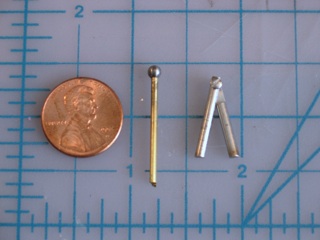you are here [x]: Scarlet Star Studios > the Scarlet Letters > armatures: limits of miniaturization
<< before
birthday card: shu-ju wang
after >>
tutorial: how to drill a 1/8” ball
August 24, 2009
armatures: limits of miniaturization
by sven at 1:30 pm

Within the field of armatures, I've decided to specialize in "small and precise." Working on The Whisperer in Darkness (new blog!) has given me a great opportunity to push my previous limits.
In the photo above, the ball is 1/8" in diameter and is brazed to a 1/16" dia. rod. The hinge joint is made from 3/32" dia. rods, and a #0-80 screw. For comparison, the screws in your glasses are likely #0.
These sizes represent certain practical limitations.
Stainless steel balls are made in two sizes smaller than the 1/8" ball I used: 3/32" and 1/16". However, you typically want to use rod that is one-half the diameter of the ball. The usual 1018 steel used for rods in armatures only goes down to 1/8" dia -- so you have to switch over to stainless steel rod, which only goes down to 1/16".
A 1/16" rod could go into a 3/32" ball -- but the range of movement would be rather limited.
Theoretically, you could also use a lathe to thin 1/16" rod down to 1/32", so you could put it into the tiniest 1/16" ball… But at that point, the rod is so fragile, I wouldn't trust it not to bend during use.
Even with the 1/16" rod, bending is an issue. It might be used on the fingers of a hand, or possibly for the outer arms of a very small puppet (~6" in height, or shorter)… But if you fantasize about using it for Jack Skellington style legs, you're bound for heartbreak when you accidentally bend the rods while animating.
So, if you want rods one-half the diameter of balls, and use standard-size rods, then a 1/8" ball and 1/16" rod combo is the limit.
As for hinge joints: the limiting factor is the screw.
I purchase nearly all my raw materials from either McMaster-Carr or Small Parts, Inc. For the hinge, I used a stainless steel 18-8, slotted, binding head machine screw.
Small Parts offers sizes of this type of screw below #0-80: #00-90 and #000-120. However, once you go past #0, prices are ten times as expensive. Whereas a box of a hundred #0 screws costs $7.25, a box of a hundred #00 screws costs $76.95!
[This is according to my invaluable Small Parts catalog from a few years back. Unfortunately, the company has stopped printing catalogs, and now does everything online. On the plus side, though, Small Parts' entire inventory can now be accessed via Amazon.com's "Industrial & Scientific" department… Although, frustratingly, it's turning out that items are out of stock far more often than I'd like.]
Furthermore, in order to drill holes to tap (make threaded), you'll need to go below the standard numbered drills, which run from #1-#60. To make a hole to tap for #00-90 screws, you need a #65 drill. For #000-120 screws, you need a #71 drill.
Personally, I have a set of #61-80 drills on hand… But they look like hairs -- so I haven't dared to try using them yet.
Oh, and in case you're wondering: another set of drills was created not so long ago that goes from #81 to #97. The #97 is .006" thick. For comparison, a piece of notepad paper is .002" thick. So try to imagine a drill that's only as thick as three sheets of paper!
At this point in history, #97 seems to be as small as drills go -- but I wouldn't bet that things stay that way forever.
Anyway, back to topic: making a hinge from 3/32" rod seems to be the practical limit. You could try to make a hinge from 1/16" rod… But the price of the screws skyrockets -- and you move into sizes of drills that are perilously delicate.
posted by sven | August 24, 2009 1:30 PM | categories: stopmo